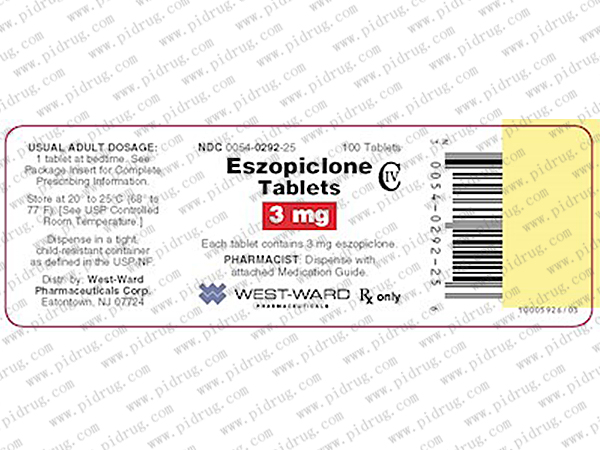艾司佐匹克隆有较好的耐受性,常见的不良反应是味觉异常、头晕、胸痛、偏头痛。本品不产生依赖性,很少引起记忆损害。
eszopiclone
Eszopiclone, sold under the brand-name Lunesta, is a medication used in the treatment of insomnia.[2][2]
It is a nonbenzodiazepine hypnotic agent. Eszopiclone is the active dextrorotatorystereoisomer of zopiclone, and belongs to the class of drugs known as cyclopyrrolones. It is also classified as a therapeutic sedative hypnotic and pharmacological cyclopyrrolone.[3]
Eszopiclone is not marketed in the European Union following a 2009 decision by the EMAdenying it new active substance status,[4] in which it ruled that eszopiclone was too similar to zopiclone to be considered a new patentable product.[5] Eszopiclone is now available in a generic form in the United States as of May 2014. On May 15, 2014, the USFDA asked that the starting dose of Eszopiclone (Lunesta) be lowered from 2 milligrams to 1 milligram after it was observed in a study that even 8 hours after taking the drug at night, some patients were not able to cope with their next-day activities like driving and other activities that require full alertness.[6] It works by interacting with the GABA receptors.[3]
In 2016 it was the 286th most prescribed medication in the United States with more than a million prescriptions.[7]
Medical uses
A Cochrane report published October 2018 found that eszopiclone produces moderate improvement in sleep onset and maintenance. The authors suggest that where preferred non-pharmacological treatment strategies have been exhausted, eszopiclone provides an efficient treatment for insomnia.[8]
Eszopiclone is slightly effective in the treatment of insomnia where difficulty in falling asleep is the primary complaint.[2] Kirsch et al. found the benefit over placebo to be of questionable clinical significance.[2] Although the drug effect and the placebo response were rather small and of questionable clinical importance, the two together produce a reasonably large clinical response.[2] It is not recommended for chronic use in the elderly.[9]
Elderly
Sedative hypnotic drugs including eszopiclone are more commonly prescribed to the elderly than to younger patients despite benefits of medication being generally unimpressive. Care should be taken in choosing an appropriate hypnotic drug and if drug therapy is initiated it should be initiated at the lowest possible dose to minimise side effects.[10]
In 2015, the American Geriatrics Society reviewed the safety information about eszopiclone and similar drugs and concluded that the "nonbenzodiazepine, benzodiazepine receptor agonist hypnotics (eszopiclone, zaleplon, zolpidem) are to be avoided without consideration of duration of use because of their association with harms balanced with their minimal efficacy in treating insomnia."
The review made this determination both because of the relatively large dangers to elderly individuals from zolpidem and other "z-drugs" together with the fact the drugs have "minimal efficacy in treating insomnia." This was a change from the 2012 AGS recommendation, which suggested limiting use to 90 days or less. The review stated "the 90‐day‐use caveat [was] removed from nonbenzodiazepine, benzodiazepine receptor agonist hypnotics, resulting in an unambiguous 'avoid' statement (without caveats) because of the increase in the evidence of harm in this area since the 2012 update." [11]
An extensive review of the medical literature regarding the management of insomnia and the elderly found that there is considerable evidence of the effectiveness and durability of non-drug treatments for insomnia in adults of all ages and that these interventions are underutilized. Compared with the benzodiazepines, the nonbenzodiazepine sedative-hypnotics, including eszopiclone appeared to offer few, if any, significant clinical advantages in efficacy or tolerability in elderly persons. It was found that newer agents with novel mechanisms of action and improved safety profiles, such as the melatonin receptor agonists, hold promise for the management of chronic insomnia in elderly people. Long-term use of sedative-hypnotics for insomnia lacks an evidence base and has traditionally been discouraged for reasons that include concerns about such potential adverse drug effects as cognitive impairment (anterograde amnesia), daytime sedation, motor incoordination, and increased risk of motor vehicle accidents and falls. In addition, the effectiveness and safety of long-term use of these agents remain to be determined. It was concluded that more research is needed to evaluate the long-term effects of treatment and the most appropriate management strategy for elderly persons with chronic insomnia.[12]
A 2009 meta-analysis found a higher rate of infections.[13]
Adverse effects
Sleeping pills, including eszopiclone, have been associated with an increased risk of death.[14]
Hypersensitivity to eszopiclone is a contra-indication to its use. Some side effects are more common than others. Recommendations around use of eszopiclone may be altered by other health conditions. These conditions or circumstances may occur in people that have lowered metabolism and other conditions. The presence of liver impairment, lactation and activities requiring mental alertness (e.g. driving) may be considered when determining frequency and dosage.[3]
§ unpleasant taste[3]
§ headache[3]
§ peripheral edema[3][15]
§ chest pain[3]
§ abnormal thinking[3]
§ behavior changes[3]
§ depression[3][15]
§ hallucinations[3][15]
§ sleep driving[3] and sleepwalking
§ dry mouth[3]
§ rash[3][15]
§ altered sleep patterns[3]
§ impaired coordination[3]
§ dizziness[3]
§ daytime drowsiness[3]
§ itching[15]
§ painful or frequent urination[15]
§ back pain[15]
§ aggressive behavior[15]
§ confusion[15]
§ agitation[15]
§ suicidal thoughts[15]
§ depersonalisation[15]
§ amnesia[15]
A 2009 meta-analysis found a 44% higher rate of mild infections, such as pharyngitis or sinusitis, in people taking Eszopiclone or other hypnotic drugs compared to those taking a placebo.[16]
Overdose
According to the U.S. Prescribing Information, overdoses of eszopiclone up to 90 times the recommended dose have been reported in which the patient fully recovered. According to the May 2014 edition of the official U.S. Prescribing Information, fatalities have been reported only in cases in which eszopliclone was combined with other drugs or alcohol.[18]
Texas poison control centers reported that during 2005–2006 there were 525 total eszopiclone overdoses recorded in the state of Texas, the majority of which were intentional suicide attempts.[19]
If consumed within the last hour, eszopiclone overdose can be treated with the administration of activated charcoal or via gastric lavage.[20]


